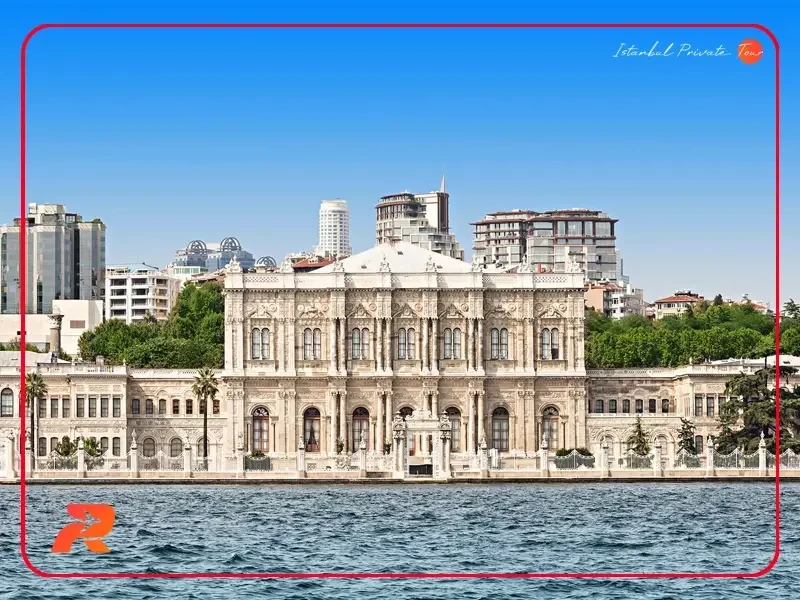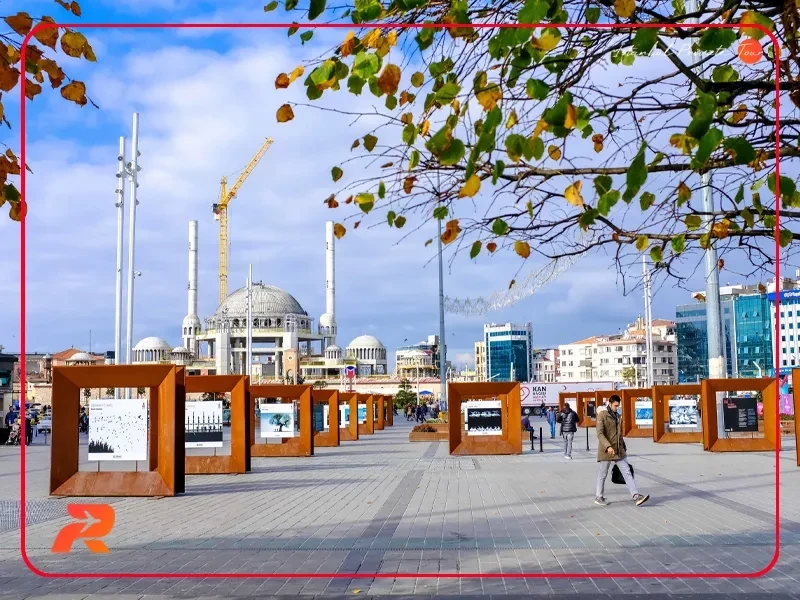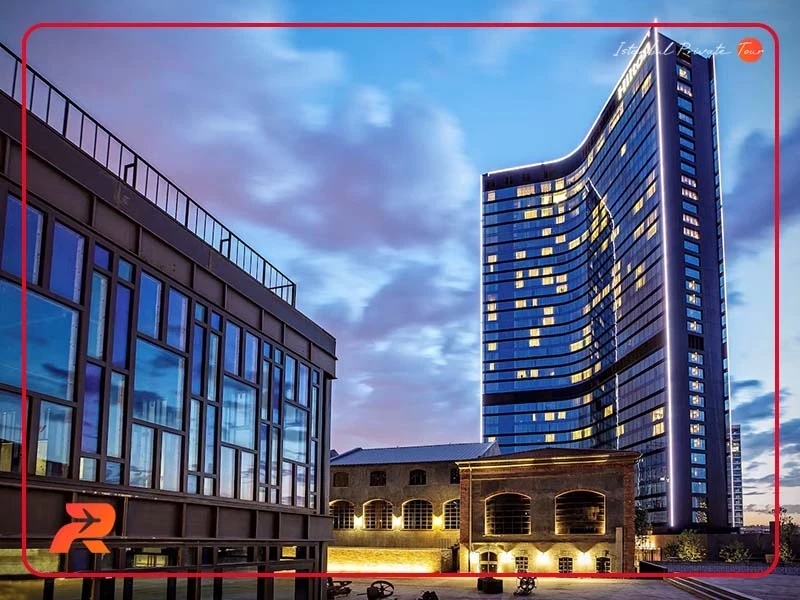The Dolmabahce Palace in Istanbul

Nestled on the European coast of the Bosphorus, Dolmabahçe Palace stands as a testament to Turkey's rich history. This grand edifice, once the administrative heart of the Ottoman Empire, is a marvel of 19th-century architecture.
The palace's design is a fusion of East and West. It blends traditional Ottoman architecture with European styles like Baroque, Rococo, and Neoclassical. This blend is a reflection of the cultural shifts happening during its construction.
Inside, the palace is a journey through opulence. From the gold-gilded ceilings to the largest collection of Bohemian and Baccarat crystal chandeliers in the world, every corner of Dolmabahçe Palace exudes grandeur. It's a glimpse into the lavish lifestyle of the Ottoman sultans.
But Dolmabahçe Palace is more than just a symbol of past extravagance. It's also a monument to the birth of modern Turkey. It was here that Mustafa Kemal Atatürk, the founder of the Turkish Republic, spent his last days.
Today, Dolmabahçe Palace serves as a museum, inviting visitors from around the world to explore its rich history and stunning beauty. Whether you're a history enthusiast, an architecture aficionado, or a curious traveler, this palace is a must-visit destination when in Istanbul.
The Historical Significance of Dolmabahçe Palace
Dolmabahçe Palace holds a significant place in Turkish history. It served as the main administrative center of the Ottoman Empire from 1856 until the empire's fall in 1922. This period marked the transition from old customs to modernization efforts within the empire.
Commissioned by Sultan Abdülmecid I, the palace's construction began in 1843. It was completed in 1856, reflecting the empire's ambition to showcase its might. The palace's completion was a statement of power and prestige on the world stage.
As the first European-style palace in Turkey, Dolmabahçe was equipped with the era's latest amenities. Features included gas lighting and central heating. It stood as a symbol of progress and embraced Western influences during a time of reform.
Dolmabahçe also witnessed the twilight of Ottoman rule and the dawn of the Turkish Republic. It became the site where Mustafa Kemal Atatürk, the founder of modern Turkey, died in 1938. His presence in the palace marks its significance in the national narrative.
Today, as a museum, Dolmabahçe Palace embodies a rich cultural legacy. It offers insights into the historical evolution of Turkey from an imperial power to a modern republic. Its historical importance continues to resonate, drawing visitors eager to explore its past.
Architectural Marvel: A Blend of East and West
Dolmabahçe Palace is a breathtaking architectural wonder. Its design is a harmonious blend of traditional Ottoman elements with European styles. Visitors can observe the influence of Baroque, Rococo, and Neoclassical architecture.
The architects Garabet Balyan and his son Nigoğayos Balyan, both of whom were Ottoman Armenians, masterminded the design. They skillfully combined diverse styles. Their work resulted in an elegant and cohesive structure.
Covering an area of 45,000 square meters, the palace features intricate stone and marble exteriors. The use of Marmara marble showcases local materials while adding elegance. The palace’s grandeur is immediately apparent from its impressive exterior.
Inside, the palace dazzles with opulent decorations. Hereke carpets and crystal staircases complement the lavish interiors. Imported French furniture adds to the luxury, creating an aura of unmatched magnificence.
Dolmabahçe is a masterpiece of 19th-century architecture. It illustrates the Ottoman Empire's desire to modernize and adapt to the changing times. The palace stands as a testament to cultural fusion and architectural brilliance.
Inside the Palace: A Journey Through Opulence
Stepping inside Dolmabahçe Palace, one is greeted by sheer opulence. Each corner tells a story of grandeur. The palace interior is rich with luxurious details.
The rooms are adorned with intricate decorations. Ceilings glitter with 14 tons of gold leaf. This lavish design exemplifies the wealth of the Ottoman Empire.
Visitors walk on exquisite Hereke carpets. These carpets, known for their intricate patterns, are woven with fine wool and silk. They add warmth and beauty to the marble floors.
Furniture from Europe enhances the palace's interiors. This includes pieces from France, mirroring the preferences of European royalty. Such selections reflect the sultans' admiration of foreign elegance.
Elegant parquet floors add to the grandeur. They're crafted with high precision. The parquet designs complement the elaborate ceilings above.
The palace also boasts a stunning collection of art. Its halls are lined with works by both Ottoman and European painters. This melding of art styles speaks to Istanbul’s cultural crossroads.
Among the notable spaces is the Crystal Staircase. Made of Baccarat crystal, brass, and mahogany, it is a focal point of the interior. The staircase exemplifies the attention to luxurious detail throughout the palace.
A journey through Dolmabahçe isn’t just a visual feast. It provides insight into the lavish lives of Ottoman royalty. It’s a poignant glimpse into an era of immense wealth and cultural exchange.
The Ceremonial Hall and Its Majestic Chandelier
The Ceremonial Hall is a highlight of the palace. It is vast and breathtaking. This magnificent room was used for state occasions.
Its focal point is a massive 4.5-ton chandelier. This dazzling masterpiece was a gift from Queen Victoria. It remains a symbol of opulence and diplomacy.
The chandelier is the largest Bohemian crystal chandelier globally. It showcases intricate craftsmanship. Visitors often find it to be a highlight of their tour.
The Harem: A Glimpse into Private Lives
The Harem section provides insight into the private lives of the sultans' families. It was a sanctuary away from formal state affairs. This secluded area housed the Sultan’s family members.
It includes the private apartments of the Sultan. These rooms display a more personal and intimate setting. Despite its privacy, opulence is still abundant here.
The Harem’s design reflects comfort with luxury. Its layout offered privacy while retaining intricate decoration. This part of the palace remains fascinating for its historical significance.
The Atatürk Museum Section
One of the significant sections in the palace is the Atatürk Museum. It is dedicated to Mustafa Kemal Atatürk, the founder of modern Turkey. Atatürk spent his final days here.
The museum exhibits personal artifacts and memorabilia. They offer an intimate look into Atatürk’s life and legacy. It helps visitors understand his immense contribution to modern Turkey.
Atatürk died in Dolmabahçe Palace in 1938. The clock in his room is stopped at 9:05 AM, marking the time of his death. This poignant detail preserves his memory within the palace walls.
The Palace Gardens and Exterior Design
Dolmabahçe Palace's gardens are as exquisite as its interiors. They provide a serene contrast to the opulence inside. Lush flora and carefully tended lawns create a peaceful retreat.
The garden design incorporates both traditional Ottoman styles and European influences. It includes geometric flower beds and fountains. These elements add elegance and tranquility to the grounds.
Two monumental gates, the Imperial Gate and the Treasury Gate, are prominent features. They showcase intricate Ottoman architectural details. These gates mark the palace's majestic entranceways.
The palace's exterior stretches along the Bosphorus, offering stunning sea views. Constructed with stone and marble, the façade reflects sunlight beautifully. It serves as an outstanding example of 19th-century design excellence.
The choice of Marmara marble and harmonious colors enhances the exterior’s aesthetic. This blend of material and form exemplifies the palace's grandeur. Visitors often marvel at the seamless integration of architecture and natural surroundings.
Dolmabahçe Palace Museum: A Treasure Trove of Art
Within the walls of Dolmabahçe Palace lies a remarkable museum. It houses a vast array of art and historical artifacts. These pieces provide insight into the cultural and artistic heritage of Turkey.
The museum features an exceptional collection of European and Ottoman paintings. These works depict pivotal historical events and personalities. They offer a unique glimpse into the past.
Visitors will find the National Palaces Painting Museum located in the Crown Prince Residence. This section showcases a rich selection of masterpieces. It stands as a testament to the palace's artistic legacy.
Beyond paintings, the museum exhibits luxurious furnishings and ornate decorations. These items reflect the tastes of the Ottoman sultans. Together, they form a comprehensive display of opulence and history.
Visiting Dolmabahçe Palace: Tips and Insights
Visiting Dolmabahçe Palace can be a memorable experience. It's vital to plan your visit wisely. Understanding the logistics can enhance your trip.
The palace is open to the public, but it's advised to check the timings. It tends to get crowded, especially during peak seasons. Purchasing tickets in advance can save you from long queues.
Here are some useful tips to consider before your visit:
- Check visiting hours: Ensure the palace is open when you plan to visit.
- Guided tours: Consider hiring a guide for detailed insights.
- No photography indoors: Respect the rules regarding photos.
- Wear comfortable shoes: You'll be walking quite a bit.
- Respect the artwork: Refrain from touching displays.
Understanding these aspects enhances your experience at this historical marvel. Each section of the palace tells a different story. Immerse yourself in the opulence and history of Dolmabahçe Palace.
Touring the Palace: What to Expect
As you step inside Dolmabahçe Palace, prepare to be awed. Guided tours are available, offering rich historical context. They help you appreciate the grandeur and significance of each room.
Expect strict guidelines during your tour. Photography is generally not allowed inside. This rule ensures the preservation of the artworks and artifacts.
Exploring the expansive palace can take several hours. Visitors are encouraged to pace themselves. Savoring the beauty and history is a rewarding experience.
Preserving History: Conservation Efforts
Preserving the grandeur of Dolmabahçe Palace is a continuous task. The Directorate of National Palaces oversees its maintenance. Their efforts ensure the palace's original splendor remains intact.
Conservation projects focus on restoring delicate artwork and architecture. This includes repairing intricate ceilings and parquet floors. Such work helps maintain the palace's historical authenticity.
The environmental factors also require attention. Protection measures are in place to manage wear and tear. These efforts safeguard this treasure for future generations.
Dolmabahçe Palace in Modern Culture
Dolmabahçe Palace continues to hold cultural significance in modern Turkey. Its architectural wonders capture the attention of scholars and tourists. This historical site remains a symbol of the country's rich heritage.
Cultural events and exhibitions are often held at the palace. These activities highlight its enduring relevance. They draw artists, historians, and visitors from around the world, showcasing Turkey's vibrant culture.
Today, Dolmabahçe Palace is not just a relic of the past. Its influence extends into contemporary arts and literature. The palace is prominently featured in films, books, and artworks, serving as inspiration for many creative endeavors.
Conclusion: The Enduring Legacy of Dolmabahçe Palace
Dolmabahçe Palace stands as a remarkable testament to Turkey's rich history. Its architectural grandeur and historical importance captivate all who visit. The palace bridges past and present, offering a glimpse into the Ottoman era.
The legacy of Dolmabahçe Palace is not just in its opulent halls but in its cultural contributions. It connects many generations through its stories and art, fostering an appreciation for Turkish heritage. Visitors leave with a deeper understanding of its role in history.
This palace remains a cherished emblem of national pride. Its preservation ensures future generations can witness its magnificence. Dolmabahçe Palace continues to inspire awe and reverence, serving as a timeless window into Turkey's glorious past.
Similar Posts

Taksim Square in Istanbul
Taksim Square in Istanbul occupies a special place in the hearts of the visitors, as it combines the authenticity of history with the modernity of the current era and provides the visitors with enjoyable activities

Hilton Istanbul Bomonti Hotel
Hilton Istanbul Bomonti is a premium five-star hotel located in Şişli, Istanbul. With luxurious rooms overlooking the Bosphorus, a full-service spa, high-end dining options, and top-tier meeting facilities, the hotel offers a refined stay experience for all types of travelers. Whether for business or leisure, guests can enjoy the perfect combination of elegance and comfort in one of the city's most vibrant locations.


